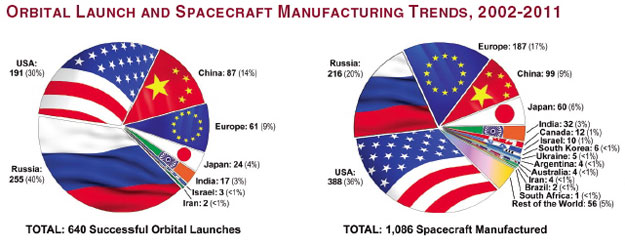TEHRAN (FNA)- Head of Iran's Space Agency Hamid Fazeli announced on Tuesday that the country will send 6 new home-made satellites, mostly made by Iranian universities, to the space in the next Iranian year (starting on March 21).
"Based on the foreseen timeline, Fajr, Sharif Sat, Tolou, Zafar, and A-Test will be sent to the space by the end of the next year," Fazeli told reporters in Tehran today.
He said that Mesbah is also among the satellites which will be sent to orbit next year.
Fazeli also announced that Iran will send a home-made satellite named Nahid to the space by the end of the current Iranian year.
Earlier this month, Iran unveiled a prototype model of Nahid telecommunications satellite.
The prototype model was unveiled during a ceremony attended by Iranian President Mahmoud Ahmadinejad, Defense Minister Ahmad Vahidi and Fazeli at an exhibition of Iran's latest space achievements and technologies here in the capital.
Also earlier today, President of Iran's Amirkabir University Alireza Rahayee announced that "A-Test and Nahid are ready to be launched and sent into the orbit".
"The engineering model of A-Test satellite has been unveiled and its launch prototype is also ready and we hope that it will be sent into the orbit soon," he added, addressing the 12th conference of Iran's aerospace association in Tehran on Tuesday.
Rahayee also said that studies on satellite Nahid have been carried out in cooperation with the Iranian Space Industry (ISA), adding that the satellite will be ready for launch next year.
In November, Rahayee had announced that researchers at Amirkabir University of Technology had accomplished part of the studies on Satellite Nahid, and said it would be launched into the space with the backing of the Iranian Space Agency (ISA).
Rahayee noted that the industrial phases of the project had accomplished and researchers were now working on the launch phase.
Fars News Agency :: Iran to Send 6 New Home-Made Satellites into Orbit Next Year
Iran to Orbit 2 New Home-Made Satellites in Near Future
TEHRAN (FNA)- Iran plans to send 2 new home-made satellites into the space in the near future, a senior Iranian academic official announced on Tuesday.
"The A-Test and Nahid satellites are ready to be launched and sent into the orbit," Chancellor of Amir Kabir University of Technology (Tehran Polytechnic) Alireza Rahayee said, addressing the 12th conference of Iran's aerospace association in Tehran on Tuesday.
"The engineering model of A-Test satellite has been unveiled and its launch prototype is also ready and we hope that it will be sent into the orbit soon," he added.
Rahayee also said that studies on satellite Nahid have been carried out in cooperation with the Iranian Space Industry (ISA), adding that the satellite will be ready for launch next year.
The Islamic Republic, which first put a satellite into orbit in 2009, has outlined an ambitious space program and has, thus far, made giant progress in the field despite western sanctions and pressures against its advancement.
Iran has taken wide strides in aerospace. The country sent the first biocapsule of living creatures into space in February 2011, using its home-made Kavoshgar-3 (Explorer-3) carrier.
Iranian President Mahmoud Ahmadinejad announced in 2010 that Iran plans to send astronauts into space in 2024. But, later he said that the issue had gone under a second study at a cabinet meeting and that the cabinet had decided to implement the plan in 2019, five years earlier than the date envisaged in the original plan.
Omid (hope) was Iran's first research satellite that was designed for gathering information and testing equipment. After orbiting for three months, Omid successfully completed its mission without any problem. It completed more than 700 orbits over seven weeks and reentered the Earth's atmosphere on April 25, 2009.
After launching Omid, Tehran unveiled three new satellites called Tolou, Mesbah II and Navid, respectively. Iran has also unveiled its latest achievements in designing and producing satellite carriers.
A new generation of home-made satellites and a new satellite carrier called Simorgh (Phoenix) were among the latest achievements unveiled by Iran's aerospace industries.
Iran plans to display its new achievements in space fields by sending heavier home-made satellites to higher altitudes by the next few years.
There would be a new round of space progression in Iran by 2013 and the country would be able to put satellites into orbit of up to 36,000 km.
Late January, the Defense Ministry's Aerospace Industries Organization announced that it has sent a monkey into the space on the back of Pishgam (Pioneer) explorer rocket, and that it has brought back and recovered the living cargo.
The Aerospace Industries Organization said it had sent the living creature into space aboard an indigenous biocapsule as a prelude to sending humans into space.
The Aerospace Industries Organization said the capsule was sent to an orbit beyond 120km in altitude and carried out telemetry of the environmental data records.
The explorer rocket was launched by the Aerospace Industries Organization and it returned to the Earth after reaching the desired speed and altitude, and the living creature (monkey) was retrieved and found alive.
http://english.farsnews.com/newstext.php?nn=9107145856






























